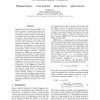Free Online Productivity Tools
i2Speak
i2Symbol
i2OCR
iTex2Img
iWeb2Print
iWeb2Shot
i2Type
iPdf2Split
iPdf2Merge
i2Bopomofo
i2Arabic
i2Style
i2Image
i2PDF
iLatex2Rtf
Sci2ools
EMNLP
2008
2008
Lattice-based Minimum Error Rate Training for Statistical Machine Translation
Minimum Error Rate Training (MERT) is an effective means to estimate the feature function weights of a linear model such that an automated evaluation criterion for measuring system performance can directly be optimized in training. To accomplish this, the training procedure determines for each feature function its exact error surface on a given set of candidate translations. The feature function weights are then adjusted by traversing the error surface combined over all sentences and picking those values for which the resulting error count reaches a minimum. Typically, candidates in MERT are represented as Nbest lists which contain the N most probable translation hypotheses produced by a decoder. In this paper, we present a novel algorithm that allows for efficiently constructing and representing the exact error surface of all translations that are encoded in a phrase lattice. Compared to N-best MERT, the number of candidate translations thus taken into account increases by several or...
EMNLP 2008 | Error Surface | Exact Error Surface | Feature Function Weights | Natural Language Processing |
| Added | 29 Oct 2010 |
| Updated | 29 Oct 2010 |
| Type | Conference |
| Year | 2008 |
| Where | EMNLP |
| Authors | Wolfgang Macherey, Franz Josef Och, Ignacio Thayer, Jakob Uszkoreit |
Comments (0)

